Undergraduate Research Report: Conformity and Cultural Impact
VerifiedAdded on 2022/10/15
|11
|3124
|16
Report
AI Summary
This research report investigates conformity, a type of social influence involving changes in belief or behavior to fit in with a group. The study examines conformity bias by comparing participant responses in self-trials versus confederate trials. Quantitative data analysis is used to interpret results, focusing on collectivist and individualist cultural groups based on Hofstede's work. The experiment, modeled on Asch's line judgment task, presents participants with a target line and three test lines, with confederate responses influencing participant choices. Results indicate that individuals from collectivist cultures exhibit higher levels of conformity compared to those from individualist cultures, particularly when confederate responses are incorrect. The study's findings highlight the interplay of senses, anticipation, and experiences, shaping behaviors in social settings and the impact of cultural perspectives on decision-making processes.
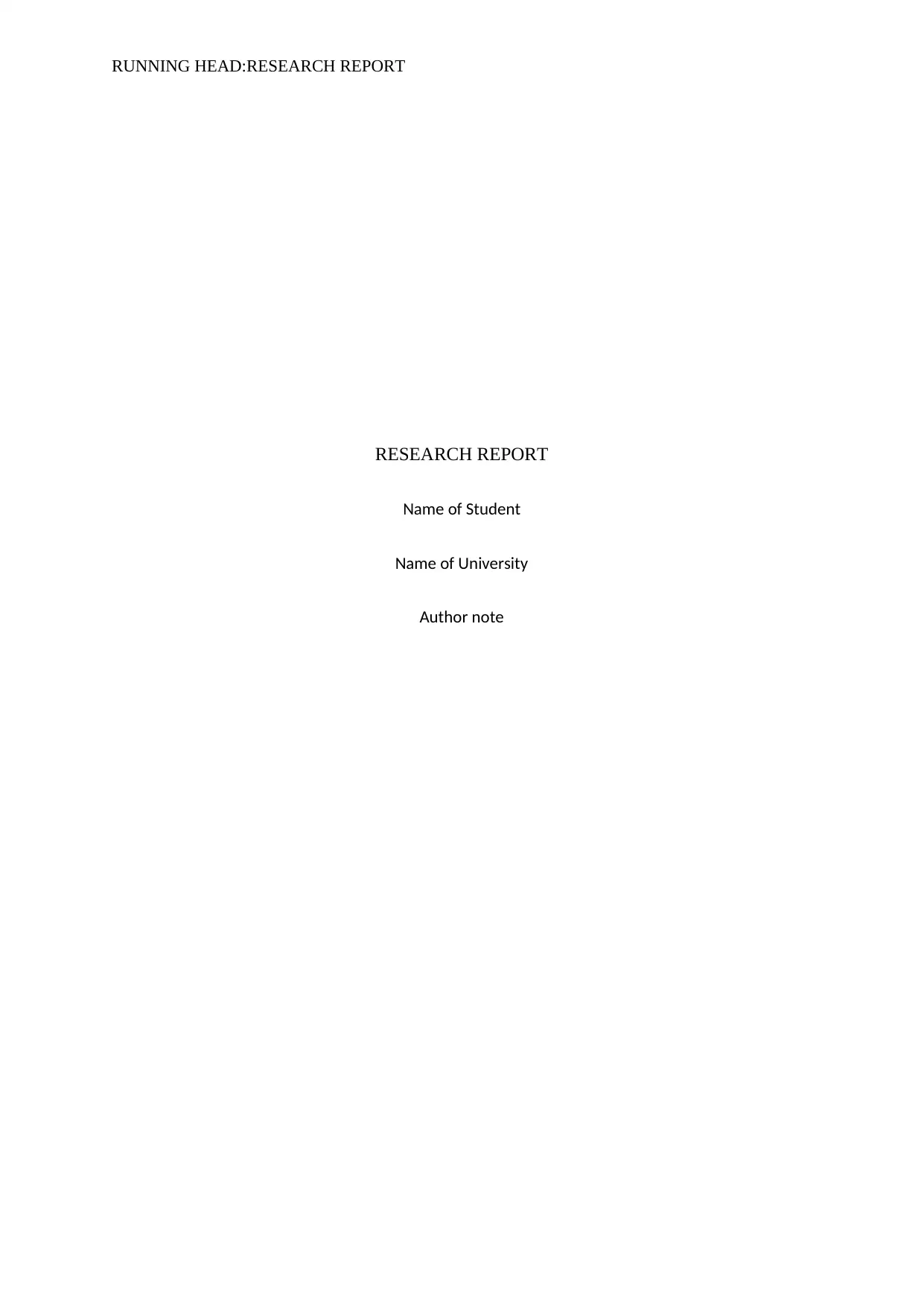
RUNNING HEAD:RESEARCH REPORT
RESEARCH REPORT
Name of Student
Name of University
Author note
RESEARCH REPORT
Name of Student
Name of University
Author note
Paraphrase This Document
Need a fresh take? Get an instant paraphrase of this document with our AI Paraphraser

1
RESEARCH REPORT
ABSTRACT
‘Conformity’ is a kind of ‘social influence’comprising a belief change and
‘behavioural change’ to fit within some group. The study aims to understand confirmation
bias.A conformity can be determined in comparison with the number of providedincorrect
responses by participant while completion of a‘SELF-trial’ as compared to performed
CONFEDERATE trials.The ‘statistical analysis’is‘undertaken to analyse and scrutinize the
data’. The ‘quantitative data studies’ provides a‘quantifiable’, an ‘objective’, and helps in
‘reliable interpretation of results’. The ‘data’ of this study is used to summarize ‘issues’ and
‘aspects’ with relevance to a‘greater population’ and to replicate the same results in an
effective way. The study chose this research design as the research design in order to
eliminate any chance of personal bias from analysis of‘Quantitative’ in several ways. The
initial step used in ‘quantitative data’ analysis - is identification of the levels or the
measurement scales for being nominal, the ordinal, the interval or the ratio. The study
chooses quantitative methodology in order to organise the data in a proper way.The study
focuses on ‘self and ‘confederate trials’ in order to mimic the classical social psychology
experiments done previously with similar aims.
The data was divided into two – ‘collectivist’ and ‘individualist’, according to
Hofstede’s (1980) work and ‘t test’ was ‘conducted’ in order to define if any difference was
present at conformity level between two of the cultural groups. Conformity was resoluted by
comparing incorrect responses numbers as selected by participant when completing SELF
compared to CONFEDERATE trials.The collectivist approach is applied in order to
understand the draw on the ‘collective ideas’ based on ‘shared imagination’ and the
individualist approach is undertaken to draw on ‘individual perspectives’. Analysing the
results, the research provides perspectives by about analysing delusional perspectives of
social conformation.
RESEARCH REPORT
ABSTRACT
‘Conformity’ is a kind of ‘social influence’comprising a belief change and
‘behavioural change’ to fit within some group. The study aims to understand confirmation
bias.A conformity can be determined in comparison with the number of providedincorrect
responses by participant while completion of a‘SELF-trial’ as compared to performed
CONFEDERATE trials.The ‘statistical analysis’is‘undertaken to analyse and scrutinize the
data’. The ‘quantitative data studies’ provides a‘quantifiable’, an ‘objective’, and helps in
‘reliable interpretation of results’. The ‘data’ of this study is used to summarize ‘issues’ and
‘aspects’ with relevance to a‘greater population’ and to replicate the same results in an
effective way. The study chose this research design as the research design in order to
eliminate any chance of personal bias from analysis of‘Quantitative’ in several ways. The
initial step used in ‘quantitative data’ analysis - is identification of the levels or the
measurement scales for being nominal, the ordinal, the interval or the ratio. The study
chooses quantitative methodology in order to organise the data in a proper way.The study
focuses on ‘self and ‘confederate trials’ in order to mimic the classical social psychology
experiments done previously with similar aims.
The data was divided into two – ‘collectivist’ and ‘individualist’, according to
Hofstede’s (1980) work and ‘t test’ was ‘conducted’ in order to define if any difference was
present at conformity level between two of the cultural groups. Conformity was resoluted by
comparing incorrect responses numbers as selected by participant when completing SELF
compared to CONFEDERATE trials.The collectivist approach is applied in order to
understand the draw on the ‘collective ideas’ based on ‘shared imagination’ and the
individualist approach is undertaken to draw on ‘individual perspectives’. Analysing the
results, the research provides perspectives by about analysing delusional perspectives of
social conformation.
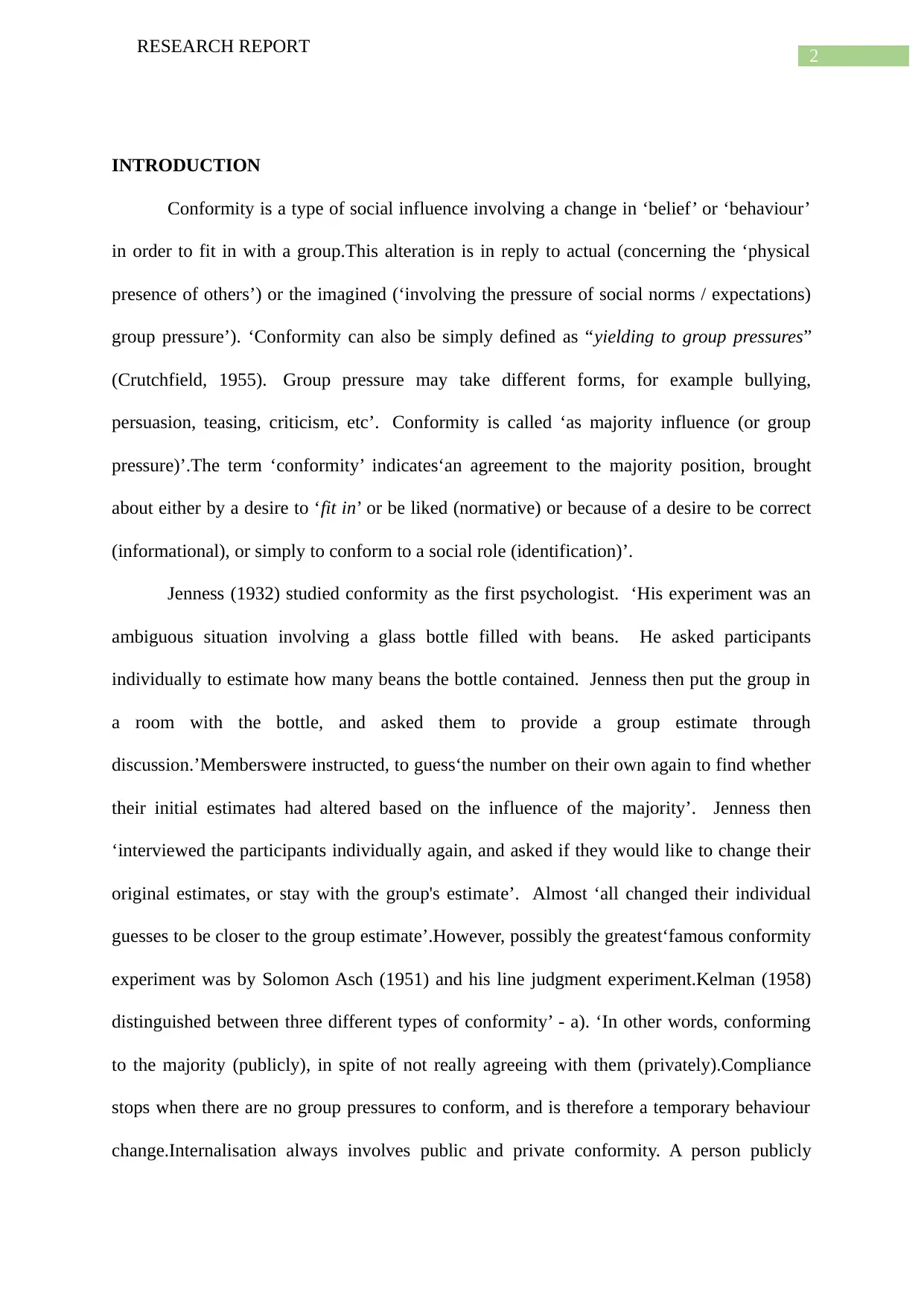
2
RESEARCH REPORT
INTRODUCTION
Conformity is a type of social influence involving a change in ‘belief’ or ‘behaviour’
in order to fit in with a group.This alteration is in reply to actual (concerning the ‘physical
presence of others’) or the imagined (‘involving the pressure of social norms / expectations)
group pressure’). ‘Conformity can also be simply defined as “yielding to group pressures”
(Crutchfield, 1955). Group pressure may take different forms, for example bullying,
persuasion, teasing, criticism, etc’. Conformity is called ‘as majority influence (or group
pressure)’.The term ‘conformity’ indicates‘an agreement to the majority position, brought
about either by a desire to ‘fit in’ or be liked (normative) or because of a desire to be correct
(informational), or simply to conform to a social role (identification)’.
Jenness (1932) studied conformity as the first psychologist. ‘His experiment was an
ambiguous situation involving a glass bottle filled with beans. He asked participants
individually to estimate how many beans the bottle contained. Jenness then put the group in
a room with the bottle, and asked them to provide a group estimate through
discussion.’Memberswere instructed, to guess‘the number on their own again to find whether
their initial estimates had altered based on the influence of the majority’. Jenness then
‘interviewed the participants individually again, and asked if they would like to change their
original estimates, or stay with the group's estimate’. Almost ‘all changed their individual
guesses to be closer to the group estimate’.However, possibly the greatest‘famous conformity
experiment was by Solomon Asch (1951) and his line judgment experiment.Kelman (1958)
distinguished between three different types of conformity’ - a). ‘In other words, conforming
to the majority (publicly), in spite of not really agreeing with them (privately).Compliance
stops when there are no group pressures to conform, and is therefore a temporary behaviour
change.Internalisation always involves public and private conformity. A person publicly
RESEARCH REPORT
INTRODUCTION
Conformity is a type of social influence involving a change in ‘belief’ or ‘behaviour’
in order to fit in with a group.This alteration is in reply to actual (concerning the ‘physical
presence of others’) or the imagined (‘involving the pressure of social norms / expectations)
group pressure’). ‘Conformity can also be simply defined as “yielding to group pressures”
(Crutchfield, 1955). Group pressure may take different forms, for example bullying,
persuasion, teasing, criticism, etc’. Conformity is called ‘as majority influence (or group
pressure)’.The term ‘conformity’ indicates‘an agreement to the majority position, brought
about either by a desire to ‘fit in’ or be liked (normative) or because of a desire to be correct
(informational), or simply to conform to a social role (identification)’.
Jenness (1932) studied conformity as the first psychologist. ‘His experiment was an
ambiguous situation involving a glass bottle filled with beans. He asked participants
individually to estimate how many beans the bottle contained. Jenness then put the group in
a room with the bottle, and asked them to provide a group estimate through
discussion.’Memberswere instructed, to guess‘the number on their own again to find whether
their initial estimates had altered based on the influence of the majority’. Jenness then
‘interviewed the participants individually again, and asked if they would like to change their
original estimates, or stay with the group's estimate’. Almost ‘all changed their individual
guesses to be closer to the group estimate’.However, possibly the greatest‘famous conformity
experiment was by Solomon Asch (1951) and his line judgment experiment.Kelman (1958)
distinguished between three different types of conformity’ - a). ‘In other words, conforming
to the majority (publicly), in spite of not really agreeing with them (privately).Compliance
stops when there are no group pressures to conform, and is therefore a temporary behaviour
change.Internalisation always involves public and private conformity. A person publicly
⊘ This is a preview!⊘
Do you want full access?
Subscribe today to unlock all pages.

Trusted by 1+ million students worldwide

3
RESEARCH REPORT
changes their behaviour to fit in with the group, while also agreeing with them privately. This
is the deepest level of conformity were the beliefs of the group become part of the
individual’s own belief system’. This means the alteration in ‘behaviour’ is perpetual. ‘This is
seen in Sherif’s‘autokinetic’ experiment’.This is most probable to happen when the
mainstream have better knowledge, and associates of the ‘minority have little knowledge to
challenge the majority position’. ‘Individuals’ conform to ‘the expectations of a social role’,
e.g police officers and nurses. It is alike to ‘compliance’ as ‘there does not have to be a
change in private opinion.’‘This is when a person conforms to impress or gain
favor/acceptance from other people. It is similar to normative influence, but is motivated by
the need for social rewards rather than the threat of rejection, i.e., group pressure does not
enter the decision to conform.’
‘Deutsch and Gerrard (1955) identified two reasons why people conform: Normative
Conformity: Yielding to group pressure because a person wants to fit in with the group’. E.g.
‘Asch Line Study.Conforming because the person is scared of being rejected by the
group.This type of conformity usually involves compliance – where a person publicly accepts
the views of a group but privately rejects them’.‘Informational Conformity’–‘This usually
occurs when a person lacks knowledge and looks to the group for guidance.Or when a person
is in an ambiguous (i.e. unclear) situation and socially compares their behavior with the
group’. ‘E.g. Sherif's Study.This type of conformity usually involves internalization – where a
person accepts the views of the groups and adopts them as an individual.’
Participants
Participants were 224 (85 male and 139 female) undergraduate students from an
Australian tertiary education institution. All participants were required to be over 18 years of
age and participated in return for credit as part of a unit of study. Failure to participate did not
impact the participants’ progression in the unit of study. The mean age of the participants was
RESEARCH REPORT
changes their behaviour to fit in with the group, while also agreeing with them privately. This
is the deepest level of conformity were the beliefs of the group become part of the
individual’s own belief system’. This means the alteration in ‘behaviour’ is perpetual. ‘This is
seen in Sherif’s‘autokinetic’ experiment’.This is most probable to happen when the
mainstream have better knowledge, and associates of the ‘minority have little knowledge to
challenge the majority position’. ‘Individuals’ conform to ‘the expectations of a social role’,
e.g police officers and nurses. It is alike to ‘compliance’ as ‘there does not have to be a
change in private opinion.’‘This is when a person conforms to impress or gain
favor/acceptance from other people. It is similar to normative influence, but is motivated by
the need for social rewards rather than the threat of rejection, i.e., group pressure does not
enter the decision to conform.’
‘Deutsch and Gerrard (1955) identified two reasons why people conform: Normative
Conformity: Yielding to group pressure because a person wants to fit in with the group’. E.g.
‘Asch Line Study.Conforming because the person is scared of being rejected by the
group.This type of conformity usually involves compliance – where a person publicly accepts
the views of a group but privately rejects them’.‘Informational Conformity’–‘This usually
occurs when a person lacks knowledge and looks to the group for guidance.Or when a person
is in an ambiguous (i.e. unclear) situation and socially compares their behavior with the
group’. ‘E.g. Sherif's Study.This type of conformity usually involves internalization – where a
person accepts the views of the groups and adopts them as an individual.’
Participants
Participants were 224 (85 male and 139 female) undergraduate students from an
Australian tertiary education institution. All participants were required to be over 18 years of
age and participated in return for credit as part of a unit of study. Failure to participate did not
impact the participants’ progression in the unit of study. The mean age of the participants was
Paraphrase This Document
Need a fresh take? Get an instant paraphrase of this document with our AI Paraphraser

4
RESEARCH REPORT
27.62 years (SD = 3.38); male mean age was 28.52 years (SD = 2.14), and female mean age
was 26.85 years (SD = 3.86).
Materials
The conformity task used in this experiment ‘was modelled’ on the original work of
Asch (1956). Here participants were presented with a target line to the left of the screen and
asked to select one of three test lines located on the right of the screen that most closely
matched the target line on the left. Participants indicated their choice amongst the three lines
by selecting the corresponding letter key on the computer keyboard.
On half of the trials presented (n=48), participants made their judgement based solely
on the line stimuli presented (SELF trials), while on the other half of the trials participants
were able to view the responses of five confederate responders listed to the far right of the
screen (CONFEDERATE trials). See Figure 1 for a depiction of the two trial conditions. The
CONFEDERATE trials were designed to mimic the Asch (1956) condition where the
participant was required to respond to the stimuli in the presence of five in-person
confederates. In the current study, the confederates were not in-person responders, but rather
responses pre-selected by the experimenters and presented to all participants on the same
trials. To begin, all CONFEDERATE trials included responses that accurately indicated the
matching test line. Following the first seven trials, the remaining trials were divided between
accurate (35%) and inaccurate (65%) responses.
a.
RESEARCH REPORT
27.62 years (SD = 3.38); male mean age was 28.52 years (SD = 2.14), and female mean age
was 26.85 years (SD = 3.86).
Materials
The conformity task used in this experiment ‘was modelled’ on the original work of
Asch (1956). Here participants were presented with a target line to the left of the screen and
asked to select one of three test lines located on the right of the screen that most closely
matched the target line on the left. Participants indicated their choice amongst the three lines
by selecting the corresponding letter key on the computer keyboard.
On half of the trials presented (n=48), participants made their judgement based solely
on the line stimuli presented (SELF trials), while on the other half of the trials participants
were able to view the responses of five confederate responders listed to the far right of the
screen (CONFEDERATE trials). See Figure 1 for a depiction of the two trial conditions. The
CONFEDERATE trials were designed to mimic the Asch (1956) condition where the
participant was required to respond to the stimuli in the presence of five in-person
confederates. In the current study, the confederates were not in-person responders, but rather
responses pre-selected by the experimenters and presented to all participants on the same
trials. To begin, all CONFEDERATE trials included responses that accurately indicated the
matching test line. Following the first seven trials, the remaining trials were divided between
accurate (35%) and inaccurate (65%) responses.
a.
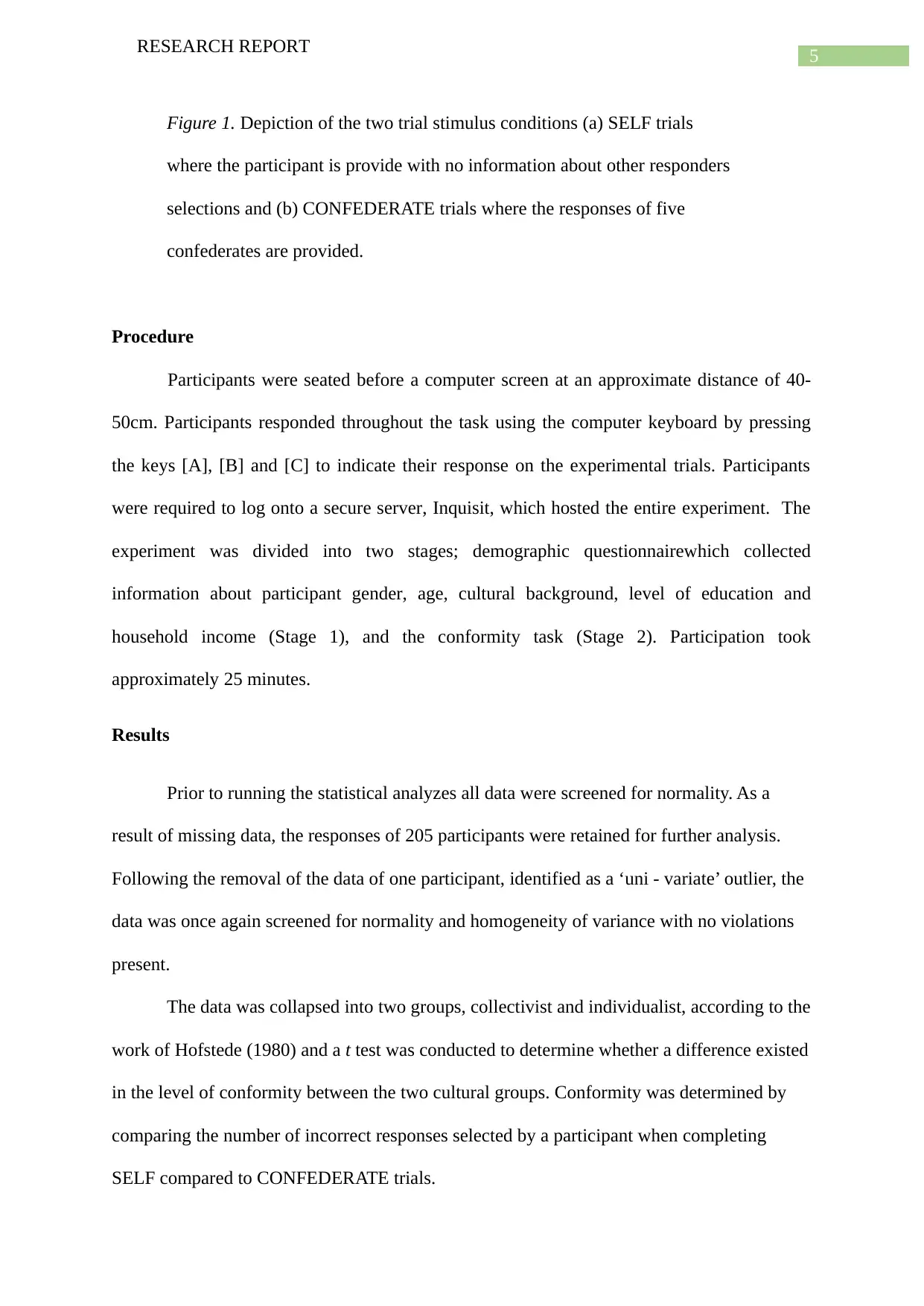
5
RESEARCH REPORT
Figure 1. Depiction of the two trial stimulus conditions (a) SELF trials
where the participant is provide with no information about other responders
selections and (b) CONFEDERATE trials where the responses of five
confederates are provided.
Procedure
Participants were seated before a computer screen at an approximate distance of 40-
50cm. Participants responded throughout the task using the computer keyboard by pressing
the keys [A], [B] and [C] to indicate their response on the experimental trials. Participants
were required to log onto a secure server, Inquisit, which hosted the entire experiment. The
experiment was divided into two stages; demographic questionnairewhich collected
information about participant gender, age, cultural background, level of education and
household income (Stage 1), and the conformity task (Stage 2). Participation took
approximately 25 minutes.
Results
Prior to running the statistical analyzes all data were screened for normality. As a
result of missing data, the responses of 205 participants were retained for further analysis.
Following the removal of the data of one participant, identified as a ‘uni - variate’ outlier, the
data was once again screened for normality and homogeneity of variance with no violations
present.
The data was collapsed into two groups, collectivist and individualist, according to the
work of Hofstede (1980) and a t test was conducted to determine whether a difference existed
in the level of conformity between the two cultural groups. Conformity was determined by
comparing the number of incorrect responses selected by a participant when completing
SELF compared to CONFEDERATE trials.
RESEARCH REPORT
Figure 1. Depiction of the two trial stimulus conditions (a) SELF trials
where the participant is provide with no information about other responders
selections and (b) CONFEDERATE trials where the responses of five
confederates are provided.
Procedure
Participants were seated before a computer screen at an approximate distance of 40-
50cm. Participants responded throughout the task using the computer keyboard by pressing
the keys [A], [B] and [C] to indicate their response on the experimental trials. Participants
were required to log onto a secure server, Inquisit, which hosted the entire experiment. The
experiment was divided into two stages; demographic questionnairewhich collected
information about participant gender, age, cultural background, level of education and
household income (Stage 1), and the conformity task (Stage 2). Participation took
approximately 25 minutes.
Results
Prior to running the statistical analyzes all data were screened for normality. As a
result of missing data, the responses of 205 participants were retained for further analysis.
Following the removal of the data of one participant, identified as a ‘uni - variate’ outlier, the
data was once again screened for normality and homogeneity of variance with no violations
present.
The data was collapsed into two groups, collectivist and individualist, according to the
work of Hofstede (1980) and a t test was conducted to determine whether a difference existed
in the level of conformity between the two cultural groups. Conformity was determined by
comparing the number of incorrect responses selected by a participant when completing
SELF compared to CONFEDERATE trials.
⊘ This is a preview!⊘
Do you want full access?
Subscribe today to unlock all pages.

Trusted by 1+ million students worldwide

6
RESEARCH REPORT
Initial analyses revealed that in general, levels of conformity in this experiment were
quite low, that is, when a participant made an error in line selection the error was not
necessarily unique to responses made on CONFEDERATE trials; that is, participants made
errors on trials where their decisions were based entirely on their own judgement and not
impacted by confederates. On those trials where errors were made on CONFEDERATE trials
approximately 35% of the errors were in agreement with the confederate responses, while
65% of errors were different to the confederate responses. Interestingly, on appraisal of trials
where the Target Line did not match with any of the Match Lines (No Match Trials), the
responses of the confederate selection did appear to be of greater influence. Specifically, on
No Match Trials 81% of participant responses matched that of the confederates.
An analysis of the influence of culture on the conformity exhibited by participants
was significant. As can be seen in Figure 2, individuals belonging to collectivist cultures
tended to make more errors on CONFEDERATE trials than did individuals from individualist
cultures. Importantly, the incorrect decisions made by individuals belonging to a collectivist
culture matched the selection of the confederates on the trial. That is, these individuals did
not merely make the wrong decision but instead that wrong decision was in line with the
confederate majority. This suggests that individuals from individualist cultures are less
impacted by the implied presence of others (n=34% of CONFEDERATE trials) and are more
likely to oppose an opinion held by the (implied) majority than individuals from collectivist
cultures (n=55% of CONFEDERATE trials).
RESEARCH REPORT
Initial analyses revealed that in general, levels of conformity in this experiment were
quite low, that is, when a participant made an error in line selection the error was not
necessarily unique to responses made on CONFEDERATE trials; that is, participants made
errors on trials where their decisions were based entirely on their own judgement and not
impacted by confederates. On those trials where errors were made on CONFEDERATE trials
approximately 35% of the errors were in agreement with the confederate responses, while
65% of errors were different to the confederate responses. Interestingly, on appraisal of trials
where the Target Line did not match with any of the Match Lines (No Match Trials), the
responses of the confederate selection did appear to be of greater influence. Specifically, on
No Match Trials 81% of participant responses matched that of the confederates.
An analysis of the influence of culture on the conformity exhibited by participants
was significant. As can be seen in Figure 2, individuals belonging to collectivist cultures
tended to make more errors on CONFEDERATE trials than did individuals from individualist
cultures. Importantly, the incorrect decisions made by individuals belonging to a collectivist
culture matched the selection of the confederates on the trial. That is, these individuals did
not merely make the wrong decision but instead that wrong decision was in line with the
confederate majority. This suggests that individuals from individualist cultures are less
impacted by the implied presence of others (n=34% of CONFEDERATE trials) and are more
likely to oppose an opinion held by the (implied) majority than individuals from collectivist
cultures (n=55% of CONFEDERATE trials).
Paraphrase This Document
Need a fresh take? Get an instant paraphrase of this document with our AI Paraphraser
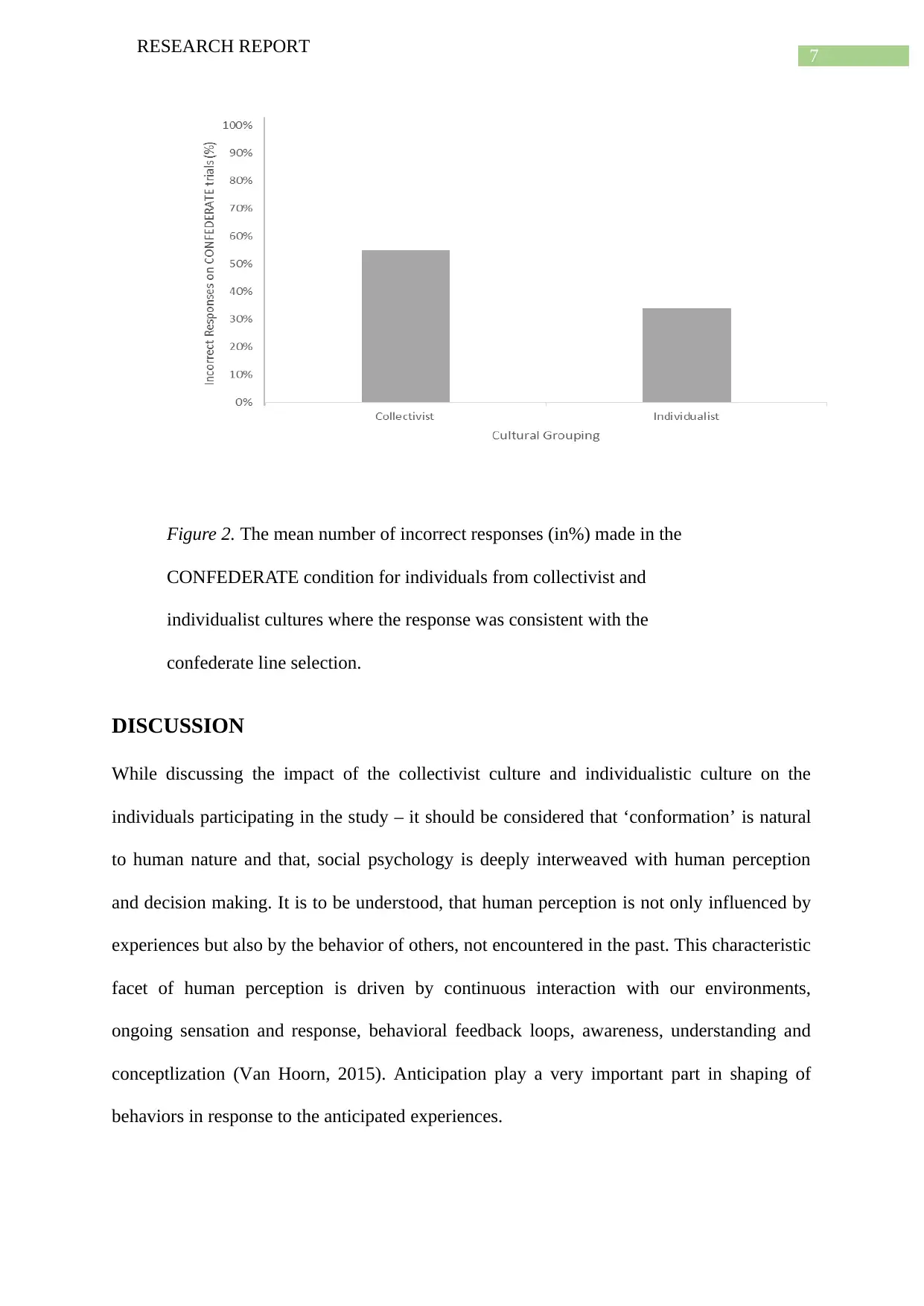
7
RESEARCH REPORT
Figure 2. The mean number of incorrect responses (in%) made in the
CONFEDERATE condition for individuals from collectivist and
individualist cultures where the response was consistent with the
confederate line selection.
DISCUSSION
While discussing the impact of the collectivist culture and individualistic culture on the
individuals participating in the study – it should be considered that ‘conformation’ is natural
to human nature and that, social psychology is deeply interweaved with human perception
and decision making. It is to be understood, that human perception is not only influenced by
experiences but also by the behavior of others, not encountered in the past. This characteristic
facet of human perception is driven by continuous interaction with our environments,
ongoing sensation and response, behavioral feedback loops, awareness, understanding and
conceptlization (Van Hoorn, 2015). Anticipation play a very important part in shaping of
behaviors in response to the anticipated experiences.
RESEARCH REPORT
Figure 2. The mean number of incorrect responses (in%) made in the
CONFEDERATE condition for individuals from collectivist and
individualist cultures where the response was consistent with the
confederate line selection.
DISCUSSION
While discussing the impact of the collectivist culture and individualistic culture on the
individuals participating in the study – it should be considered that ‘conformation’ is natural
to human nature and that, social psychology is deeply interweaved with human perception
and decision making. It is to be understood, that human perception is not only influenced by
experiences but also by the behavior of others, not encountered in the past. This characteristic
facet of human perception is driven by continuous interaction with our environments,
ongoing sensation and response, behavioral feedback loops, awareness, understanding and
conceptlization (Van Hoorn, 2015). Anticipation play a very important part in shaping of
behaviors in response to the anticipated experiences.
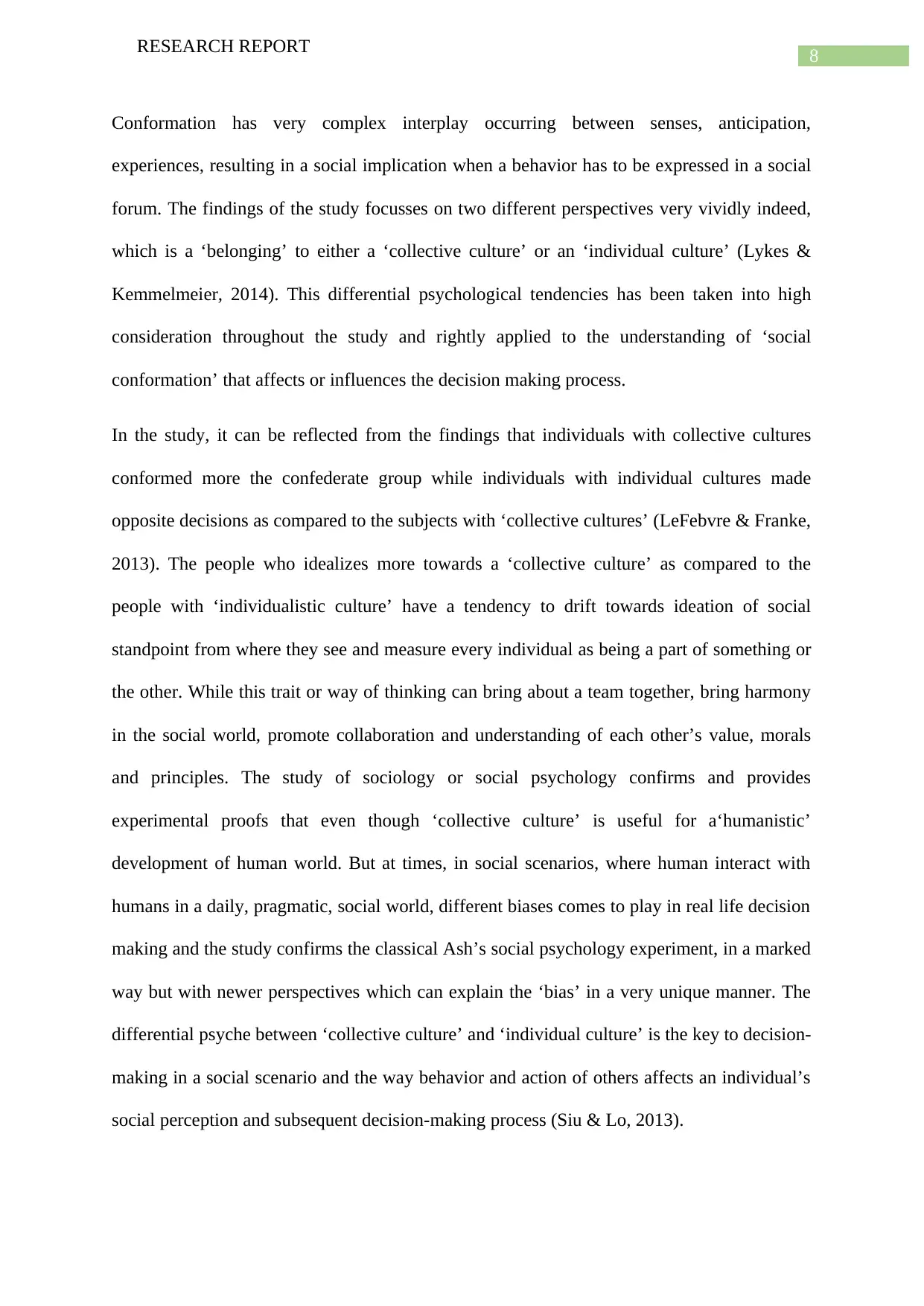
8
RESEARCH REPORT
Conformation has very complex interplay occurring between senses, anticipation,
experiences, resulting in a social implication when a behavior has to be expressed in a social
forum. The findings of the study focusses on two different perspectives very vividly indeed,
which is a ‘belonging’ to either a ‘collective culture’ or an ‘individual culture’ (Lykes &
Kemmelmeier, 2014). This differential psychological tendencies has been taken into high
consideration throughout the study and rightly applied to the understanding of ‘social
conformation’ that affects or influences the decision making process.
In the study, it can be reflected from the findings that individuals with collective cultures
conformed more the confederate group while individuals with individual cultures made
opposite decisions as compared to the subjects with ‘collective cultures’ (LeFebvre & Franke,
2013). The people who idealizes more towards a ‘collective culture’ as compared to the
people with ‘individualistic culture’ have a tendency to drift towards ideation of social
standpoint from where they see and measure every individual as being a part of something or
the other. While this trait or way of thinking can bring about a team together, bring harmony
in the social world, promote collaboration and understanding of each other’s value, morals
and principles. The study of sociology or social psychology confirms and provides
experimental proofs that even though ‘collective culture’ is useful for a‘humanistic’
development of human world. But at times, in social scenarios, where human interact with
humans in a daily, pragmatic, social world, different biases comes to play in real life decision
making and the study confirms the classical Ash’s social psychology experiment, in a marked
way but with newer perspectives which can explain the ‘bias’ in a very unique manner. The
differential psyche between ‘collective culture’ and ‘individual culture’ is the key to decision-
making in a social scenario and the way behavior and action of others affects an individual’s
social perception and subsequent decision-making process (Siu & Lo, 2013).
RESEARCH REPORT
Conformation has very complex interplay occurring between senses, anticipation,
experiences, resulting in a social implication when a behavior has to be expressed in a social
forum. The findings of the study focusses on two different perspectives very vividly indeed,
which is a ‘belonging’ to either a ‘collective culture’ or an ‘individual culture’ (Lykes &
Kemmelmeier, 2014). This differential psychological tendencies has been taken into high
consideration throughout the study and rightly applied to the understanding of ‘social
conformation’ that affects or influences the decision making process.
In the study, it can be reflected from the findings that individuals with collective cultures
conformed more the confederate group while individuals with individual cultures made
opposite decisions as compared to the subjects with ‘collective cultures’ (LeFebvre & Franke,
2013). The people who idealizes more towards a ‘collective culture’ as compared to the
people with ‘individualistic culture’ have a tendency to drift towards ideation of social
standpoint from where they see and measure every individual as being a part of something or
the other. While this trait or way of thinking can bring about a team together, bring harmony
in the social world, promote collaboration and understanding of each other’s value, morals
and principles. The study of sociology or social psychology confirms and provides
experimental proofs that even though ‘collective culture’ is useful for a‘humanistic’
development of human world. But at times, in social scenarios, where human interact with
humans in a daily, pragmatic, social world, different biases comes to play in real life decision
making and the study confirms the classical Ash’s social psychology experiment, in a marked
way but with newer perspectives which can explain the ‘bias’ in a very unique manner. The
differential psyche between ‘collective culture’ and ‘individual culture’ is the key to decision-
making in a social scenario and the way behavior and action of others affects an individual’s
social perception and subsequent decision-making process (Siu & Lo, 2013).
⊘ This is a preview!⊘
Do you want full access?
Subscribe today to unlock all pages.

Trusted by 1+ million students worldwide
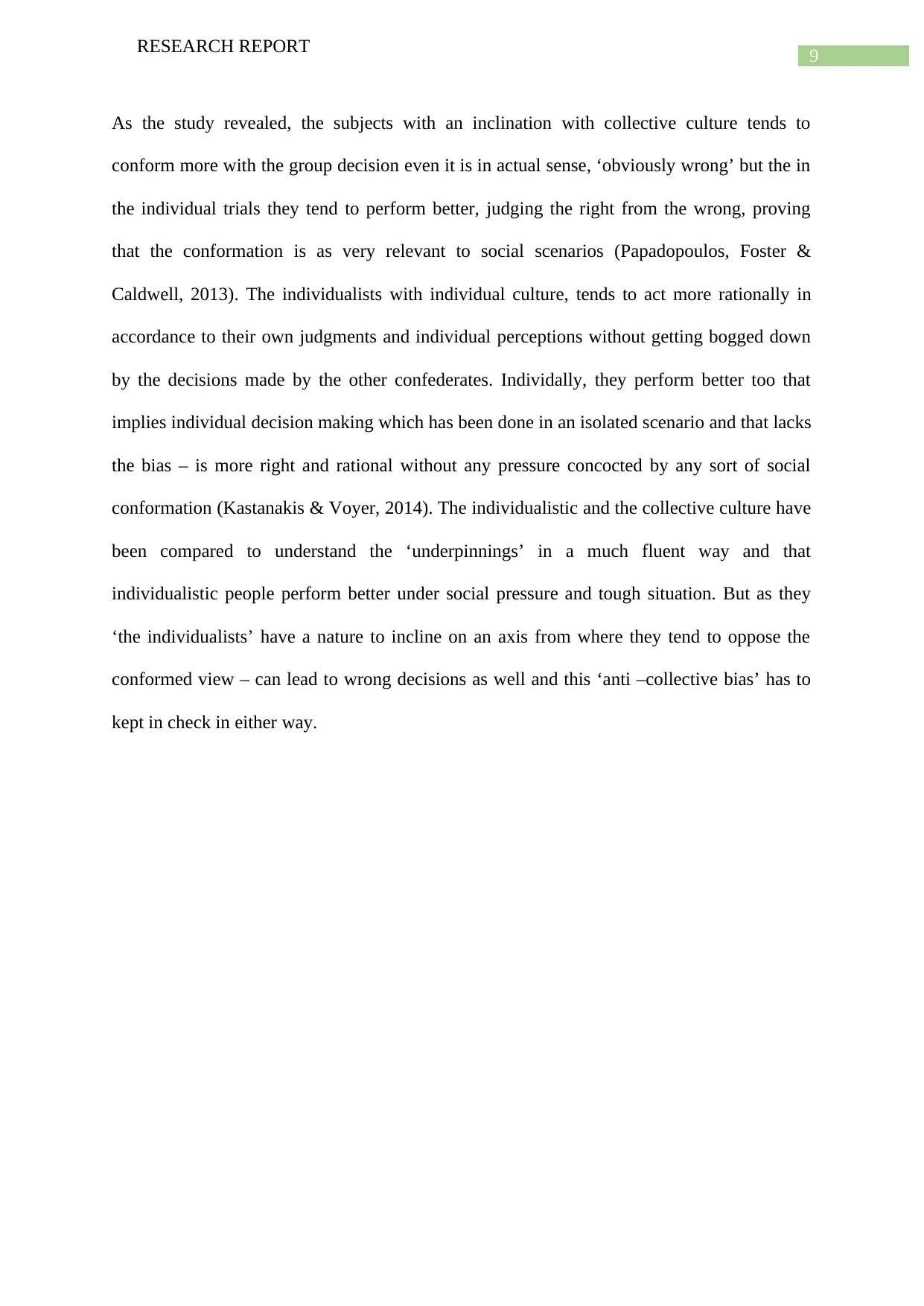
9
RESEARCH REPORT
As the study revealed, the subjects with an inclination with collective culture tends to
conform more with the group decision even it is in actual sense, ‘obviously wrong’ but the in
the individual trials they tend to perform better, judging the right from the wrong, proving
that the conformation is as very relevant to social scenarios (Papadopoulos, Foster &
Caldwell, 2013). The individualists with individual culture, tends to act more rationally in
accordance to their own judgments and individual perceptions without getting bogged down
by the decisions made by the other confederates. Individally, they perform better too that
implies individual decision making which has been done in an isolated scenario and that lacks
the bias – is more right and rational without any pressure concocted by any sort of social
conformation (Kastanakis & Voyer, 2014). The individualistic and the collective culture have
been compared to understand the ‘underpinnings’ in a much fluent way and that
individualistic people perform better under social pressure and tough situation. But as they
‘the individualists’ have a nature to incline on an axis from where they tend to oppose the
conformed view – can lead to wrong decisions as well and this ‘anti –collective bias’ has to
kept in check in either way.
RESEARCH REPORT
As the study revealed, the subjects with an inclination with collective culture tends to
conform more with the group decision even it is in actual sense, ‘obviously wrong’ but the in
the individual trials they tend to perform better, judging the right from the wrong, proving
that the conformation is as very relevant to social scenarios (Papadopoulos, Foster &
Caldwell, 2013). The individualists with individual culture, tends to act more rationally in
accordance to their own judgments and individual perceptions without getting bogged down
by the decisions made by the other confederates. Individally, they perform better too that
implies individual decision making which has been done in an isolated scenario and that lacks
the bias – is more right and rational without any pressure concocted by any sort of social
conformation (Kastanakis & Voyer, 2014). The individualistic and the collective culture have
been compared to understand the ‘underpinnings’ in a much fluent way and that
individualistic people perform better under social pressure and tough situation. But as they
‘the individualists’ have a nature to incline on an axis from where they tend to oppose the
conformed view – can lead to wrong decisions as well and this ‘anti –collective bias’ has to
kept in check in either way.
Paraphrase This Document
Need a fresh take? Get an instant paraphrase of this document with our AI Paraphraser
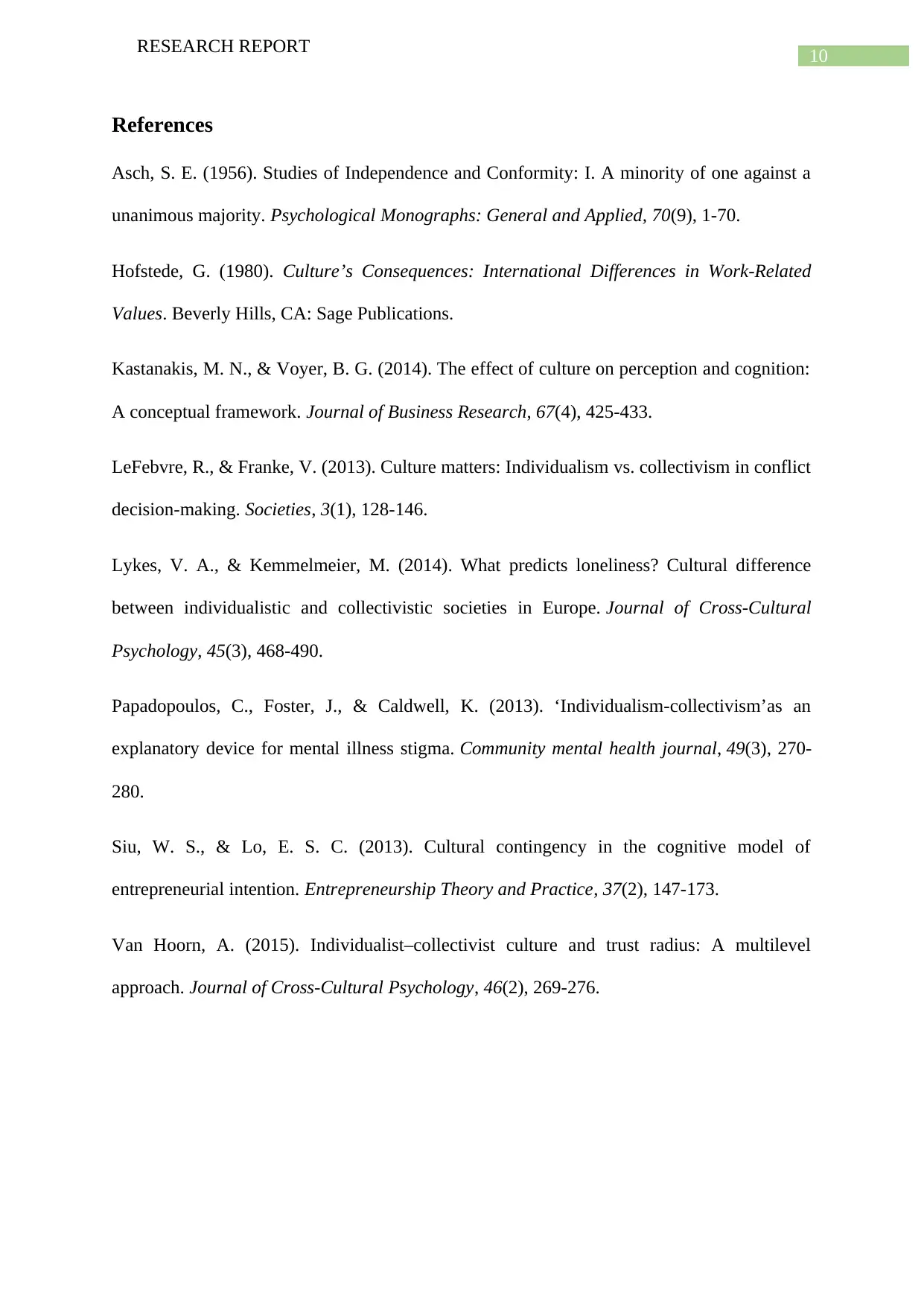
10
RESEARCH REPORT
References
Asch, S. E. (1956). Studies of Independence and Conformity: I. A minority of one against a
unanimous majority. Psychological Monographs: General and Applied, 70(9), 1-70.
Hofstede, G. (1980). Culture’s Consequences: International Differences in Work-Related
Values. Beverly Hills, CA: Sage Publications.
Kastanakis, M. N., & Voyer, B. G. (2014). The effect of culture on perception and cognition:
A conceptual framework. Journal of Business Research, 67(4), 425-433.
LeFebvre, R., & Franke, V. (2013). Culture matters: Individualism vs. collectivism in conflict
decision-making. Societies, 3(1), 128-146.
Lykes, V. A., & Kemmelmeier, M. (2014). What predicts loneliness? Cultural difference
between individualistic and collectivistic societies in Europe. Journal of Cross-Cultural
Psychology, 45(3), 468-490.
Papadopoulos, C., Foster, J., & Caldwell, K. (2013). ‘Individualism-collectivism’as an
explanatory device for mental illness stigma. Community mental health journal, 49(3), 270-
280.
Siu, W. S., & Lo, E. S. C. (2013). Cultural contingency in the cognitive model of
entrepreneurial intention. Entrepreneurship Theory and Practice, 37(2), 147-173.
Van Hoorn, A. (2015). Individualist–collectivist culture and trust radius: A multilevel
approach. Journal of Cross-Cultural Psychology, 46(2), 269-276.
RESEARCH REPORT
References
Asch, S. E. (1956). Studies of Independence and Conformity: I. A minority of one against a
unanimous majority. Psychological Monographs: General and Applied, 70(9), 1-70.
Hofstede, G. (1980). Culture’s Consequences: International Differences in Work-Related
Values. Beverly Hills, CA: Sage Publications.
Kastanakis, M. N., & Voyer, B. G. (2014). The effect of culture on perception and cognition:
A conceptual framework. Journal of Business Research, 67(4), 425-433.
LeFebvre, R., & Franke, V. (2013). Culture matters: Individualism vs. collectivism in conflict
decision-making. Societies, 3(1), 128-146.
Lykes, V. A., & Kemmelmeier, M. (2014). What predicts loneliness? Cultural difference
between individualistic and collectivistic societies in Europe. Journal of Cross-Cultural
Psychology, 45(3), 468-490.
Papadopoulos, C., Foster, J., & Caldwell, K. (2013). ‘Individualism-collectivism’as an
explanatory device for mental illness stigma. Community mental health journal, 49(3), 270-
280.
Siu, W. S., & Lo, E. S. C. (2013). Cultural contingency in the cognitive model of
entrepreneurial intention. Entrepreneurship Theory and Practice, 37(2), 147-173.
Van Hoorn, A. (2015). Individualist–collectivist culture and trust radius: A multilevel
approach. Journal of Cross-Cultural Psychology, 46(2), 269-276.
1 out of 11
Your All-in-One AI-Powered Toolkit for Academic Success.
+13062052269
info@desklib.com
Available 24*7 on WhatsApp / Email
![[object Object]](/_next/static/media/star-bottom.7253800d.svg)
Unlock your academic potential
Copyright © 2020–2025 A2Z Services. All Rights Reserved. Developed and managed by ZUCOL.